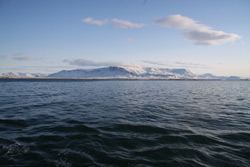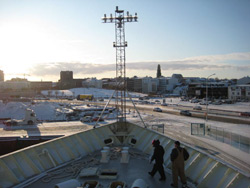Underway on the Knorr by Dallas Murphy
"Come left to three-five-zero degrees," said Kent Sheasley, captain of the Knorr, to his Chief Mate Dee Emrich, and she repeated the order before turning the Knorr toward the red-and-white mid-channel buoy. It is 9:30 am in Reykjavik, and we were on our way to sea for a 30-day expedition in the region of the Denmark Strait between Iceland and Greenland. It had snowed last night, and the coastal mountains are shimmering in the bright morning sun. This is such a magnificent part of the world, and we're thrilled to be here, even if some of us are feeling a little queasy in the unfamiliar roll of the ship. The Knorr, our home for the next month, is operated by the Woods Hole Oceanographic Institution, one of the foremost ocean-science institutions in the world. Maybe you’ve heard of the ship or seen her on television when she discovered the wreck of the Titanic. But she’s done much more important work than that, taking scientists to sea for 40 years to understand the ocean and how it works to our benefit by keeping our climate moderate. And that’s the purpose of this expedition: The ocean is sending out messages, signals about its health and about the future of our climate. But to gather the signals, you must go out there in all weather, winter and summer, in calms and violent storms. And oceans don’t cooperate with scientists (or seamen for that matter). They don’t sit still to have their temperature taken. Oceans are vast and deep and rough, and they change constantly. Just think, for now, about their size. You may have heard already that nearly 71% of our Earth is covered by salt water. The average—average—depth of the Atlantic is 12,612 feet (3,844 meters). The average height of dry land is 2,756 (840 meters). You could stack two Mt. Everests in the deepest place in the Pacific Ocean, and the water would still be over 10,000 feet deep. Imagine the difficulty of studying something that enormous, even if it just lay there all flat and gentle, like a sweet little country pond. But of course oceans aren’t like that, particularly up here in the Arctic. For instance, the captain told me that on the last trip near where we’re going in Greenland, a wave smashed one of the windows on the bridge. That’s where the steering and engine controls are located; that’s where the captain runs the ship—the bridge is 40 feet above the ocean. And in fact part of the reason we’re going to the Irminger Sea, near the Denmark Strait, in October during the storm season is to measure the effect of high wind on certain currents. So it’s going to blow, and blow hard, and it’s going to be cold, and there will be ice in the water and, well, some people will get seasick. But that’s what it takes to read the signals the ocean is sending us about our future. Our chief scientist, Dr. Bob Pickart would be delighted to have a boring, uneventful trip. He’d love to retrieve all the expensive, high-tech, gee-whiz devices he’s left out there in this cold, rough sea, and then go home with all the information they’ve collected for him. But he knows the chances of that are slim to none, for this is a hostile, angry sea; in fact it’s the windiest region in the whole world ocean. So welcome aboard. Put on your winter hats, coats, and gloves and waterproof boots, and come with us. We’ll keep you posted as to our progress. We’ll introduce you to the captain and his mates. We’ll visit the engine room with the chief engineer and the galley with the chief steward. We’ll watch as the scientists put their instruments into the water, and we’ll report to you what they find when they pull them out again. And we’ll also be sending you photos to help you visualize the work. And we’d be happy to answer any questions you might have. Don’t be shy, ask away. If I can’t answer them (my name is Dallas, by the way), then I’ll find someone for you who can. (The answers to YOUR questions will be posted on the Email Exchange pages.) We’ll ask you a few questions along the way, as well. Look up the answers, discuss them among yourselves in class. For instance, try this one: What do we mean by the “Arctic Circle”? Where is the Arctic? What countries are in the Arctic? (The answers to OUR questions will be posted on the Daily Quiz pages.) Oops, I’ve got to go now. The alarm bells just sounded. We must put on our life jackets and survival suits and report to our “muster stations” for a man overboard and fire drill. But it’s only a drill. Thankfully. So until next time, goodbye. Tikilluaqqusissut by Nick M?llerSisimiuni nalunnguarfiup atuarfiani atuartunut, tikilluaritsi umiarsuarmut ”Knorr”. Ullumikkut Island-ip umiaruslivianit avalappugut nalunaaqutaq 09:00 Kalaallit nunaata kangianut ingerlaassalluta, ulluni siullerni ornitassarivagut ukiup siuliani kivisitarinikuusaat nalunaarsuutit. Ulluni tulliuttuni una qaammat ilisimatuut qanoq sumilu sulisarnerannik nalunaarsuiffigisassavassi, apeqquteqarusakkaangassi apeqquteqartarsinnaavusi, apeqqutinik akineqarsinnaasunik soorlu; ”silaannaap kissatsikkiartornera immap uumasuaraanut qanoq sunniuteqarsimava?” Apeqqutisi ilisimatuunut ingerlatseqqittassavakka, akissutallu ilissinnut apuuttarumaarpakka. Ilisimatitsissutigissavara ilissitulli atuartut Island-imi, Tuluit nunaanni aammalu U.S.A-mi uuma ilisimasaassarsiornermut malinnaassammata, oqarnerat naapeqorlugu videocamera-kkut periarfissaqarsinnaassaaq attaveqaqatigiinnissamut, annerusumik e-mail assinillu attaveqarneq ingerlassaalluni. Nunani allani ilisimasassarsiornermut atuartut malinnaasut assingi takuneqarsinnaapput nittartakkami. Nunani allani atuartut kaliillit nunaat pillugu soqutiginninnerat annertuvoq, taammaattumik atuartut allat assigalugit ilissi atuaqatigiit ataatsimoorlusi assiliseriarlusi asseq naassiukkussiuk, nittartakkamut ikkutissamaaratsigut. Paasissutissallu atuarfissi pillugu (pisariaqarnerusut allaatigalugit) soorlu qanoq atuartoqartigineranik assigisaannillu. Neriuppunga ilisimasassarsiorneq soqutigalugu malinnaaffigissagissi, pijaartumillu akissuteqassasusi. Ullaap tungaani umiarsuaq alapernaasernerani paasivara, nunarsuarmi ilaasortaatit annersaat ”Titanic” ujarneqarmat immap naqqani, una umiarsuaq atorlugu nanineqarnikuummat. ;-) Kivisittakkat pillugit paasissutissiaq. Kivisittakkat arfineq pingasut Kalaallit nunatta kangiata imartaaniipput, nalunaarsuutaapput immap kissassusaata allanngorarneranut, tarajoqassusianut, sarfaata allanngorarneranut taamatullu immap uumasuaraanik nalunaasuutaallutik. Ukioq kaajallullugu kivisittakkat nalunaarsuisuupput, qaqinneqareerunillu atuarneqarsinnaassaaq ukioq kaajallallugu qanoq nalunaarsuisimanerannik. Kivisittakkat immap qaavaniit 50 meterit tikillugit kivisimasuupput, kisalerlugit kiversagaallutik. Ulluni tulliuttuni kivisittakkat katersussavagut, taamaasillutalu paasisat nutaat silaannaap illanngoriartorneranik imartamut qanoq sunniuteqarsimanera nalilersorsinnaassallutigut. Ulluni aggersuni paasisat, umiarsuarmilu qanoq ingerlasoqarneranik nalunaarsuisassaagut neriulluta attaveqarneq ataavartumik ingerlakkumaarlutigu. Inussiarnersumik Asilerisoq Nick Møller umiarsuarmiit Knorr. Last updated: November 6, 2009 | |||||||||||||||||||||||
Copyright ©2007 Woods Hole Oceanographic Institution, All Rights Reserved, Privacy Policy. | |||||||||||||||||||||||


